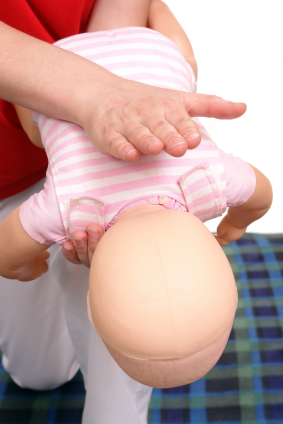Breathing problems in children are a huge worry to parents. They account for around a quarter of all acute paediatric hospital admissions and can be very serious. In this article Dr Lisa Anderson discusses the signs, symptoms and causes of acute breathing difficulties in children.
Contents
- What are the signs and symptoms of acute breathing difficulties in children?
- What are the common causes of acute breathing difficulties in children?
- Treatment for choking
- A brief look at some of the conditions that cause breathing difficulties
- Summary
What are the signs and symptoms of acute breathing difficulties in children?
This article focuses solely on acute breathing difficulties in children, but before discussing the causes I am going to discuss the signs and symptoms that should make you immediately seek medical advice.
- What is the colour of your child’s lips and tongue? – are they pink or are they blue? – if they are blue you must see a doctor quickly, looking ashen is also abnormal.
- Is your child choking? – this is an indication that the airways are obstructed and this can be due to a foreign body or to some respiratory diseases that involve airways obstruction.
Treatment of choking will be discussed later. - How fast is your child breathing? – a young child is allowed to breathe faster than an adult, what is important are the signs that show the child is struggling to breathe.
Children use what we call the accessory muscles of respiration to breathe and you should look for the following signs to see if they are struggling to breathe:- Deep drawing in of the muscles under the rib cage (subcostal recession)
- In-drawing of the muscles between each rib (intercostal recession)
- The notch at the top of the breast bone (sternum) being drawn on (sternal recession)
- Flaring of the nostrils
As a guide the following are normal breathing rates (breaths per minute/BPM) for different ages:
| Less than 1 year | 30 - 40 bpm |
| 1 - 2 years | 25 - 35 bpm |
| 2 - 5 years | 25 - 30 bpm |
| 5 - 12 years | 20 - 25 bpm |
| More than 12 years | 15 - 20 bpm |
Intercostal and sternal recession are more easily seen in young children, so if this is present in an older child it must be taken seriously. Nasal flaring is usually seen in infants aged under one year.
A reduced breathing rate can be indicative of poisoning or drug overdose.
- Are there any other noises you can hear either when the child breathes in or out?
- Wheezing – this is usually when the child breathes out (expiration) and occurs with lower airway obstruction.
- Stridor – a high pitched noise on breathing in – this is due to an obstruction of the upper airway. If you suspect this do NOT put anything in the child’s mouth or this can cause complete respiratory obstruction.
- Grunting – this is a sign of acute respiratory distress in infants.
- How alert is your child? – both drowsiness and agitation are important signs.
What are the common causes of acute breathing difficulties in children?
The most common causes of acute breathing difficulties in children are as follows:
- Ingestion of foreign body
- Acute asthma
- Allergic reaction to something
- Anaphylaxis (extreme allergic reaction)
- Upper respiratory infection – croup, epiglottitis, retropharyngeal abscess
- Lower respiratory causes – bronchiolitis, pneumonia, acute respiratory distress syndrome.
- Laryngomalacia - a condition seen in babies where the larynx is soft and limp
Treatment for choking
It is useful for all parents including those who are first aid trained to familiarise themselves with how to treat choking in children. The Resuscitation Council website has an excellent algorithm on how to treat choking and can be seen here.
The following is a brief guide to help parents:
1. Try to get the child to cough – a foreign body may be coughed up and the child may then improve, always check to make sure there is no deterioration in the child or in the effectiveness of the coughing.
2. If the cough is ineffective –
- Is the child unconscious? If so call for help, give 5 mouth to mouth breaths and start cardiopulmonary resuscitation (CPR).
- Is the child conscious? Give 5 back blows and 5 thrusts (see below).

Back blows are given by using the heel of the hand on the upper back of the child and try and create pressure and vibration to help the child dislodge a foreign body.
Abdominal thrusts – also known as the Heimlich manoeuvre should really only be performed by those who know how to do these because of the risk of injuring the child, through abdominal bruising, and rib fractures. The person performing the thrust stands behind the child and uses their hands to put pressure on the bottom of the diaphragm. This causes compression of the lungs and hopefully enough pressure to dislodge the foreign body from the trachea.
A brief look at some of the conditions that cause breathing difficulties
1. Breathing difficulties caused by acute asthma
Hopefully most children with asthma will be well controlled by using inhalers and every child should have a personalised treatment plan given to them by their GP or Practice nurse.
An acute asthma attack can be life threatening and it important for parents to recognise the severity of an acute attack. Some children with severe acute asthma do not appear wheezy – this is a dangerous, life-threatening sign and is referred to as the silent chest. Children with this will often be blue, exhausted and confused.
2. Breathing difficulties caused by anaphylaxis
This is a serious allergic reaction usually caused by particular foods, medicines, insect bites and so on. Difficulty in breathing is only one of the signs, there is swelling of the face and also the tongue, lips and throat; loss of colour and becoming clammy as blood pressure falls, and then loss of consciousness. Often children can develop allergies to certain foods, nuts being the most common, and occasionally the reaction to these allergies can become worse and cause anaphylaxis in response to ingesting them. Such children carry an Epipen containing adrenaline to treat themselves.
3. Breathing difficulties caused by croup
Croup usually affects children under the age of 5 years of age and is caused by a virus that causes inflammation of the upper airways. It is more common in spring and autumn and is characterised by a harsh barking cough, which is worse at night. Croup can usually be treated at home but parents must be aware that it can be severe and life threatening and the signs of respiratory distress as outlined earlier in the article should be looked for.
4. Breathing difficulties caused by epiglottitis
This is a life threatening condition where the epiglottis swells and causes obstruction of the windpipe. The epiglottis is a flap of tissue that sits under the tongue at the back of the throat and its function is to close over the wind pipe when you are eating so food does not go into your airway making you choke. Epiglottitis is usually caused by Haemophilus influenza Type B and as this is one of the immunisations given to babies it is now rare. The peak age range for epiglottitis is two to seven years. Initial symptoms develop very rapidly and are a severe sore throat, high temperature, difficulty swallowing and then breathing difficulties. If this condition is not treated it can be fatal.
5. Breathing difficulties caused by bronchiolitis

This is a common infection of the lower respiratory tract caused by a virus called RSV – respiratory syncytial virus, and it is more prevalent between November and March. It commonly affects babies and young children and causes the bronchioles, which are the smallest airways in the lungs, to become infected and inflamed thereby reducing the amount of air entering the lungs causing difficulty in breathing. The initial symptoms can be like those of a common cold, namely, mild fever, coughing and difficulty feeding, but it can cause wheezing leading to increased respiratory rate and respiratory distress. It is usually not severe but again can become so requiring admission to hospital and this occurs in about 3% of those infected.
6. Breathing difficulties caused by laryngomalacia
This is a condition whereby at birth the larynx is very soft and limp and can range from mild causing no problems to severe causing breathing problems. It can also be associated with gastroenterological problems such as reflux. As the baby breathes the tissues of the larynx can collapse, which interrupts the flow of air and leads to the noise of stridor – heard when breathing in. It is only rarely that this can cause a life threatening condition.
Summary
As I have discussed, there are a number of different causes of acute breathing difficulties in children and, as this can be a serious condition you should immediately consult your doctor if you are in any way concerned.
If you need to see a private GP, call 020 3883 9525. Out-of-hours doctors are available.


